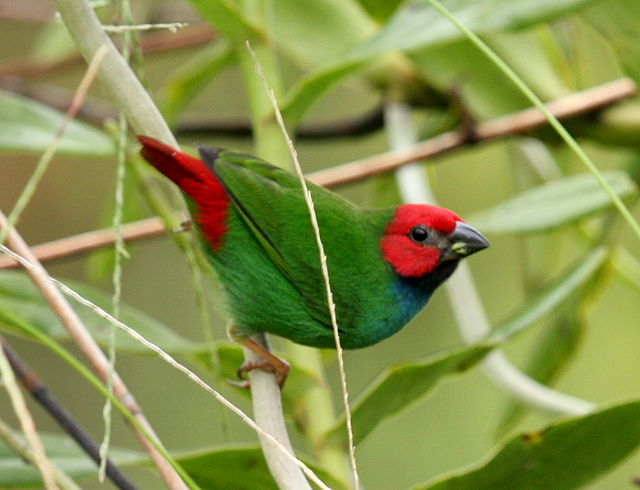The Fiji parrotfinch is a species of estrildid finch endemic to Fiji that was formerly considered to be a subspecies of the red-headed parrotfinch. This parrotfinch is a small, mainly green bird with a red head and tail and a stubby dark grey bill. It is found in both forested and open habitats, and has adapted well to man-made environments such as grasslands, pasture and gardens. Pairs have a courtship display in which they fly above the trees in an undulating flight, calling constantly. Breeding birds build a domed grass nest with a side entrance, and lay a clutch normally of four white eggs. Newly hatched chicks are naked and pink, with blue balls at the upper and lower corners of the gape, and black markings inside the mouth; older fledglings resemble the adults, but lack the red head colouring. The Fiji parrotfinch eats seeds, especially of grasses, and also readily feeds on insects and nectar. It forms small flocks of up to six birds after the breeding season.
Fiji parrotfinch
The use of carpet grass for lawns has helped the Fiji parrotfinch to use human-modified habitats like gardens.
Parrotfinch chicks have blue papillae at the corners of the gape, and distinctive mouth markings.
The endemic Fiji goshawk is a specialist predator of small birds.
Estrildidae, or estrildid finches, is a family of small seed-eating passerine birds of the Old World tropics and Australasia. They comprise species commonly known as munias, mannikins, firefinches, parrotfinches and waxbills. Despite the word "finch" being included in the common names of some species, they are not closely related to birds with this name in other families, such as the Fringillidae, Emberizidae or Passerellidae.
Estrildidae
Image: Pictorella munia taronga zoo
Image: Mountain Firetail
Image: Stagonopleura bella female Melaleuca








